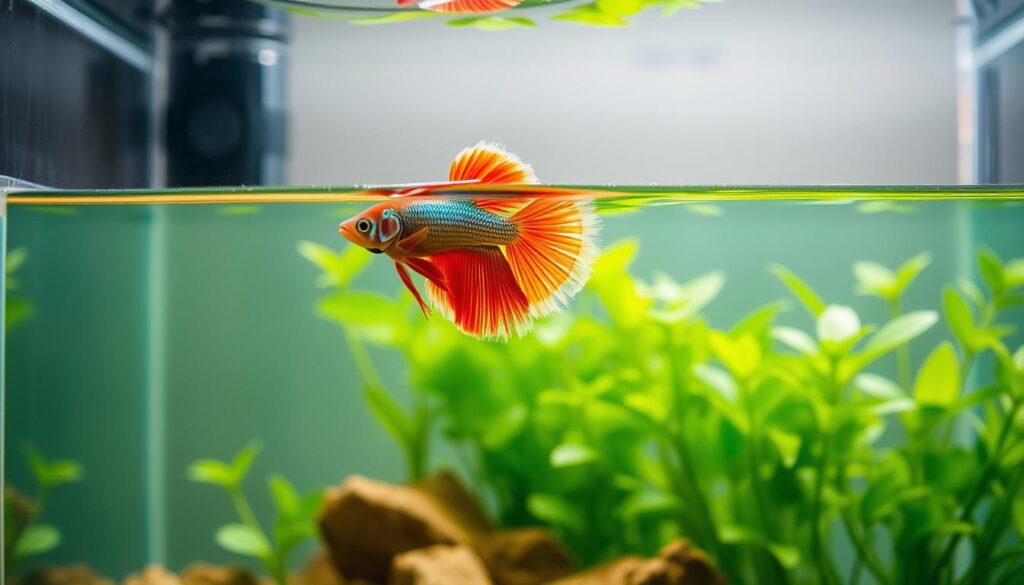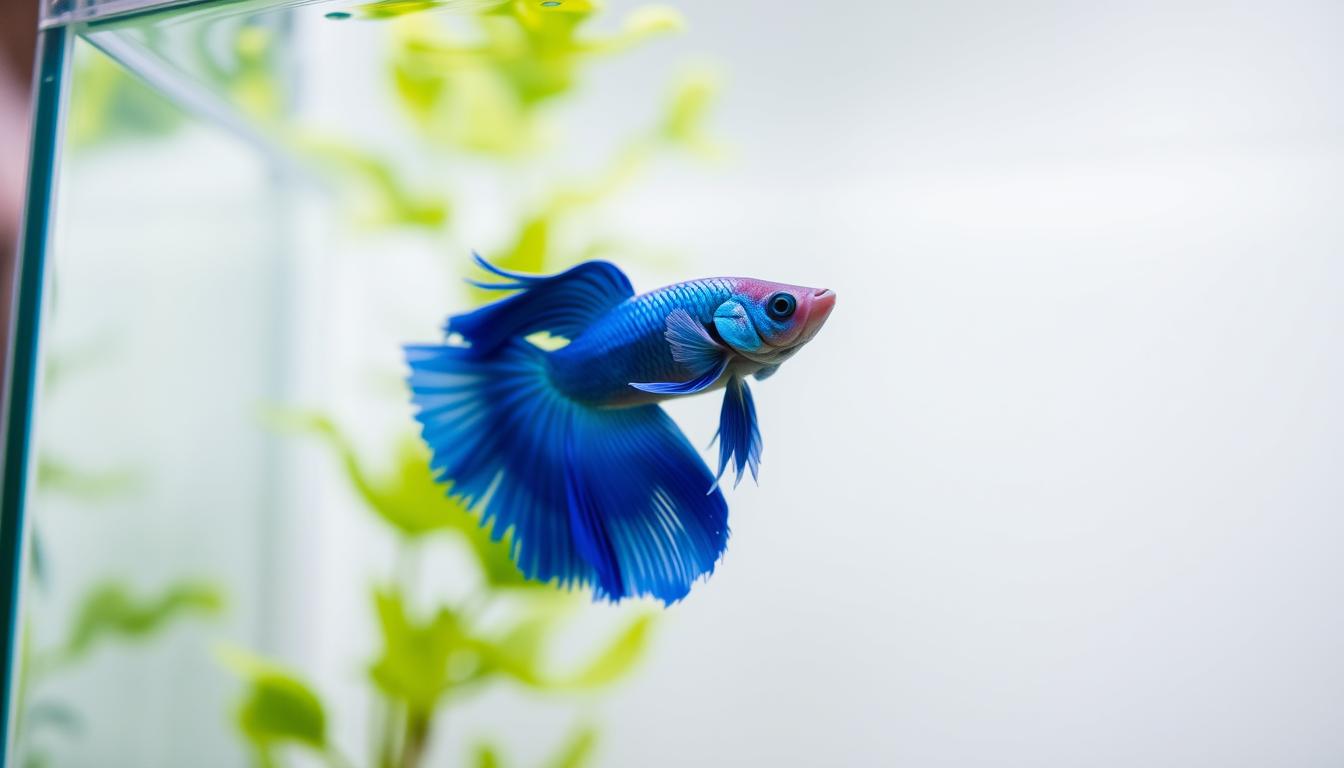If you’ve spotted your betta fish floating at top of tank but not dead, it can be confusing and even alarming. Is your fish sick? Is something wrong with the water? While bettas are known to occasionally rest near the surface, staying there for too long can signal a deeper issue. Poor water quality, swim bladder disorder, temperature shock, or even stress could be the culprit. In this guide, we’ll help you understand why your betta fish is floating at top of tank but not dead, and what steps you can take to make sure your finned friend is safe, healthy, and swimming happily again.
Key Takeaways
- Understand the common reasons behind betta fish buoyancy issues.
- Learn how to identify if your betta is in distress.
- Discover simple adjustments to make your betta more comfortable.
- Find out when it’s necessary to seek professional advice.
- Get tips on maintaining a healthy environment for your betta.
Understanding Your Betta’s Behavior
Understanding your betta’s behavior is key to ensuring they’re happy and healthy, especially when it comes to their floating habits. Betta fish are naturally inclined to swim near the surface, but it’s crucial to distinguish between normal and abnormal behaviors.
Normal vs. Abnormal Floating Behaviors
Normal floating behavior in betta fish includes occasionally swimming to the surface to breathe air or explore their surroundings. However, if your betta is consistently floating at the top without sinking or showing signs of distress, it might indicate an issue. Keep an eye out for labored breathing, lethargy, or loss of appetite, as these can be signs of an underlying problem.
Signs Your Betta Is Healthy While at the Surface
A healthy betta at the surface will typically be active, responsive to their environment, and have a good appetite. They might even be seen gulping air at the surface, which is a normal behavior thanks to their labyrinth organ. If your betta is swimming normally and reacting to food or toys, it’s likely a sign they’re doing well.
Body Positioning and What It Tells You
The way your betta positions their body can be very telling. A betta that’s floating upright or swimming normally is generally healthy. However, if they’re floating with their belly up or at an odd angle, it could indicate a swim bladder issue or other health concern.
Monitoring these behaviors closely will help you identify any potential issues early on.
Betta Fish Floating at Top of Tank But Not Dead: What’s Happening?
Ever caught your betta fish lounging at the surface and thought, ‘Is it okay?’ Let’s dive into what’s going on! Betta fish are naturally inclined to dwell near the surface due to their unique physiology.
Natural Surface-Dwelling Tendencies
Betta fish are known to be surface-dwellers. In their natural habitat, they often swim near the water’s surface to breathe air. This behavior is perfectly normal and is linked to their labyrinth organ.
Read Also Why a Betta Fish Divided Tank Can Work Wonders for Your Aquarium
Labyrinth Organ Function and Air Breathing
The labyrinth organ is a specialized respiratory structure that allows betta fish to breathe air directly from the surface. This adaptation is crucial in their native environment, where water oxygen levels can be low. So, when your betta is at the surface, it’s likely just taking a breath or two!

Distinguishing Between Resting and Distress
While betta fish often swim near the surface, there’s a fine line between resting and being in distress. If your betta is floating listlessly or showing signs of labored breathing, it might be in trouble. On the other hand, if it’s swimming around or reacting to its environment, it’s probably just chillin’!
| Signs | Resting | Distress |
|---|---|---|
| Body Position | Swimming or floating near the surface | Floating listlessly or sinking |
| Breathing | Normal breathing rate | Labored or rapid breathing |
| Reaction to Environment | Responds to food or surroundings | Lethargic or unresponsive |
By understanding these differences, you can better assess your betta’s condition and take appropriate action if needed.
Common Causes of Surface Floating in Bettas
If your betta is floating at the surface, don’t panic – let’s explore what’s going on! Betta fish floating alive at the tank surface can be caused by several factors, and understanding these is crucial to providing the right care.
Swim Bladder Disorders
One of the primary reasons betta fish float abnormally is due to swim bladder disorders. The swim bladder is an internal gas-filled organ that helps fish maintain their buoyancy. When it’s out of balance, your betta might float involuntarily.
Water Quality Issues
Poor water quality can stress your betta, leading to floating behaviors. Regular water changes and proper tank maintenance are essential to prevent this. Keep an eye on ammonia, nitrite, and nitrate levels – they can significantly impact your betta’s health.

Temperature Problems
Betta fish are sensitive to temperature fluctuations. Water that’s too cold or too hot can cause stress, leading to floating. Ensure your tank’s temperature is stable and within the ideal range for betta fish – between 76°F and 82°F.
Read Also Betta Fish Stays at Top of Tank: What It Means and What to Do
Stress and Environmental Factors
Stress from environmental factors, such as tankmates, decor, or even the tank’s location, can cause betta fish to float at the surface. Creating a comfortable, stress-free environment is key. Consider adding plants or hiding places to reduce stress.
By addressing these common causes, you can help your betta fish return to normal behavior. Remember, a healthy betta is an active, engaged betta!
Swim Bladder Disease: A Primary Culprit
If your betta fish is floating at the top of the tank but not dead, swim bladder disease could be the culprit! This condition affects the swim bladder, a critical organ that helps your betta maintain its buoyancy. When the swim bladder is compromised, your betta may experience difficulty staying submerged.
Symptoms and Diagnosis
Symptoms of swim bladder disease include floating abnormally, sinking, or having trouble maintaining a normal position in the water. To diagnose the issue, observe your betta’s behavior closely. If it’s floating unusually or showing signs of distress, it’s time to investigate further.
Different Types of Swim Bladder Issues
There are several types of swim bladder problems that can affect your betta, including bacterial infections, physical damage, or constipation. Each type requires a different approach to treatment.
Treatment Options
Treatment for swim bladder disease often involves a combination of dietary changes, environmental adjustments, and sometimes medication. For instance, fasting your betta for a few days can help alleviate constipation-related issues. Epsom salt baths can also be beneficial in reducing swelling.

By understanding the causes and symptoms of swim bladder disease, you can take the necessary steps to help your betta recover and prevent future occurrences. Keep a close eye on your betta’s behavior, and don’t hesitate to seek professional advice if you’re unsure about the best course of action.
Overfeeding and Constipation Issues
Have you ever wondered how your betta’s diet affects its buoyancy? Overfeeding is a common mistake that can lead to constipation and floating issues in betta fish. A balanced diet is crucial for maintaining their digestive health and overall buoyancy.
How Diet Affects Buoyancy
The food your betta eats can significantly impact its swim bladder function. Overfeeding can cause constipation, leading to abnormal floating behaviors. When your betta consumes more food than it can digest, it can put pressure on its swim bladder, affecting its ability to maintain proper buoyancy.
Signs of Constipation in Bettas
So, how do you know if your betta is constipated? Look out for these signs:
- Floating abnormally at the surface
- Lack of feces or very small feces
- Lethargy or loss of appetite
- A visibly swollen abdomen
Proper Feeding Guidelines
To avoid overfeeding, follow these guidelines:
- Feed your betta 2-3 times a day, but only as much as it can consume within 1-2 minutes.
- Provide a varied diet that includes high-quality commercial betta pellets and frozen or live foods.
- Avoid overfeeding with dry foods, as they can expand in the stomach.
Beneficial Foods for Digestive Health
Including certain foods in your betta’s diet can help promote digestive health. Some beneficial foods are:
- Daphnia – rich in nutrients and easy to digest
- Bloodworms – a good source of protein, but should be fed sparingly
- Brine shrimp – nutritious and can help stimulate digestion

Water Parameters That Affect Betta Buoyancy
Maintaining the right water parameters is crucial for your betta’s buoyancy and overall health! You might be surprised at how much of an impact the water quality has on your betta’s ability to swim properly.
Ideal Temperature Range
Bettas are tropical fish and thrive in warm water. The ideal temperature range for betta fish is between 76°F and 82°F (24°C to 28°C). Temperatures outside this range can cause stress, leading to buoyancy issues. Keeping the temperature consistent is key. Avoid placing your betta tank near drafty windows, radiators, or air conditioning vents.
Ammonia, Nitrite, and Nitrate Levels
Toxic compounds like ammonia and nitrite can wreak havoc on your betta’s health. Regular water testing is essential to ensure these levels are at zero. Nitrates, while less toxic, should be kept below 20 ppm. Regular water changes will help maintain safe levels.
| Parameter | Ideal Level |
|---|---|
| Ammonia | 0 ppm |
| Nitrite | 0 ppm |
| Nitrate | <20 ppm |
pH and Hardness Considerations
Bettas prefer slightly acidic to neutral water, with a pH between 6.5 and 7.5. Water hardness should be moderate, between 5 and 15 dGH. Drastic changes in pH or hardness can stress your betta, potentially leading to buoyancy issues.
“The quality of the water is just as important as the quality of the food you’re providing for your betta.” – Aquarium Expert
Testing and Maintaining Water Quality
Regular water testing and maintenance are crucial. Use a reliable water test kit to monitor parameters, and perform partial water changes weekly. This will help keep your betta healthy and swimming happily at the bottom of the tank, not just floating at the surface.
By maintaining optimal water parameters, you’ll be well on your way to creating a healthy environment for your betta to thrive. Remember, a happy betta is a healthy betta!
Tank Setup and Its Impact on Floating Behavior
A well-designed tank is essential for preventing floating issues in betta fish. The setup of your betta’s tank can significantly impact their floating behavior, and we’re here to guide you through the key factors to consider.
Appropriate Tank Size and Configuration
A suitable tank size is crucial for your betta’s health. A minimum tank size of 5 gallons is recommended, as it provides a stable environment and enough space for your betta to swim comfortably. Avoid small tanks or bowls, as they can lead to stress and swimming difficulties.
Filtration Requirements and Flow Rate
Proper filtration is vital, but betta fish prefer gentle water flow. Choose a filter with adjustable flow rates to keep the water clean without creating strong currents that might stress your betta.
Importance of Hiding Places and Plants
Including plants and hiding places in your tank can reduce stress and provide your betta with a sense of security. Live plants, such as java moss or anacharis, not only add hiding spots but also help maintain water quality.
Creating Resting Spots Near the Surface
Betta fish often rest near the surface. You can create resting spots by adding floating plants or decorations, giving your betta a comfortable place to relax without expending too much energy.
| Tank Setup Element | Benefit for Betta |
|---|---|
| Appropriate Tank Size | Stable environment, reduced stress |
| Gentle Filtration | Clean water, minimal stress |
| Hiding Places and Plants | Reduced stress, improved security |
| Resting Spots Near Surface | Comfortable resting, energy conservation |
Treatment Options for Floating Bettas
If your betta fish is floating at the top of the tank, don’t panic – there are several effective treatment options available!
Treating a floating betta requires understanding the underlying cause and applying the right remedies. Let’s explore the various treatment options you can try to help your betta recover.
Fasting Protocol
One of the simplest and most effective treatments is a fasting protocol. Sometimes, bettas float due to constipation or overeating. By fasting your betta for 2-3 days, you give its digestive system a chance to clear out. This can help alleviate swim bladder issues caused by constipation.
Epsom Salt Baths
Epsom salt baths can be beneficial for bettas experiencing swim bladder problems or constipation. To administer an Epsom salt bath, mix 1 teaspoon of Epsom salt with 5 gallons of water. Give your betta a 15-minute bath in this solution. The magnesium in Epsom salt can help reduce inflammation and improve digestion.
Medication Options
In some cases, medication may be necessary to treat underlying infections or parasites that could be causing your betta to float abnormally. Always use medications specifically designed for aquarium use and follow the instructions carefully.
Recovery Timeline Expectations
Recovery times can vary depending on the cause of your betta’s floating issue. Generally, you should start seeing improvement within a few days to a week after beginning treatment. Monitor your betta closely during this period.
When to Consult a Fish Veterinarian
If your betta’s condition doesn’t improve with home treatments or if you notice severe symptoms, it’s time to consult a fish veterinarian. They can provide a more accurate diagnosis and recommend specialized treatments.
By following these treatment options and being patient, you can help your betta fish recover from floating issues. Remember, every betta is different, so it may take some trial and error to find the right solution.
Preventative Measures to Avoid Floating Issues
Preventing floating issues in your betta fish is a lot like maintaining a healthy lifestyle for yourself – it requires a bit of effort, but it’s totally worth it! By taking a few simple steps, you can minimize the risk of your betta fish ending up at the surface, looking lifeless when they’re actually not.
Optimal Feeding Practices
One of the main reasons betta fish end up floating at the surface is due to swim bladder issues, often caused by overfeeding or a poor diet. To avoid this, feed your betta fish a balanced diet that includes a variety of nutrient-rich foods. Avoid overfeeding by only giving your betta as much food as they can consume within a few minutes.
Regular Water Maintenance Schedule
Maintaining good water quality is crucial for your betta’s health. Regular water changes (about 25% every week) can help prevent the buildup of toxins that can lead to floating issues. Make sure to test the water regularly and adjust your maintenance schedule as needed.
Stress Reduction Techniques
Stress can exacerbate floating issues in betta fish. To reduce stress, provide plenty of hiding places and plants in the tank, and avoid placing the tank in high-traffic areas or near drafty windows.
Monitoring Your Betta’s Health
Regularly monitoring your betta’s behavior and health can help you catch any potential issues early. Look out for signs of distress, such as labored breathing or lethargy, and take action promptly if you notice anything unusual.
Age and Genetic Factors in Floating Behaviors
As betta fish grow older, their bodies undergo various changes that can affect their buoyancy. It’s not uncommon for older betta fish to experience floating issues due to age-related factors.
How Aging Affects Swim Bladder Function
Aging can impact the swim bladder’s efficiency, making it harder for your betta to maintain its usual depth. This decline can be due to various factors, including reduced muscle mass and decreased organ function.
Genetic Predispositions to Buoyancy Issues
Some betta fish may be genetically more prone to buoyancy problems. Breeding practices can sometimes accentuate these issues, making it essential to monitor your betta’s behavior closely.
According to a study on betta fish health, “Genetic factors can play a significant role in the development of swim bladder disorders, which can lead to floating issues.”
“Genetic predisposition is a critical factor in understanding and addressing buoyancy problems in betta fish.”
Caring for Older Bettas with Chronic Floating
Caring for older betta fish requires attention to their changing needs. Adjusting their diet and environment can help alleviate floating issues.
| Care Tips | Benefits |
|---|---|
| Dietary adjustments | Eases digestive issues |
| Regular water changes | Maintains water quality |
| Comfortable tank setup | Reduces stress |
Conclusion
Understanding why your betta fish is floating at the top of the tank but not dead can be a real challenge! By now, you know that it’s not always a cause for panic. Sometimes, it’s just their natural behavior, like when they’re using their labyrinth organ to breathe air. Other times, it can be a sign of an underlying issue, such as swim bladder disease or water quality problems.
To keep your betta happy and healthy, remember to maintain good water quality, avoid overfeeding, and provide a stress-free environment. If you notice your betta fish is buoyant not deceased, take action quickly to address any potential issues. With proper care and attention, your betta fish swimming at the surface without passing away is just a normal part of their behavior.
By following the tips and guidelines outlined in this article, you’ll be well on your way to becoming a betta expert! So, keep a close eye on your betta’s behavior, and don’t hesitate to take action if you notice anything unusual. Your betta will thank you!

